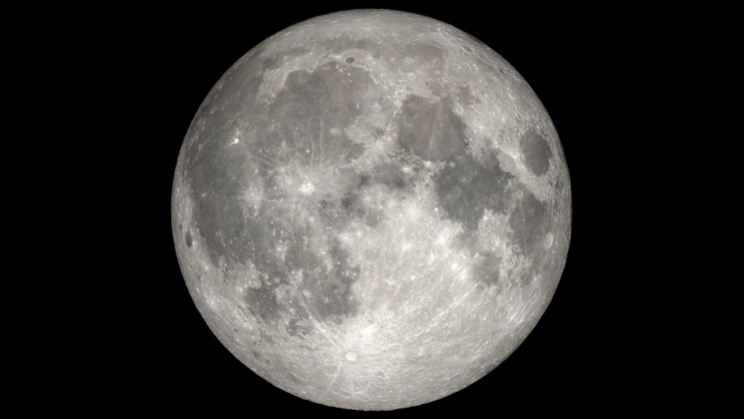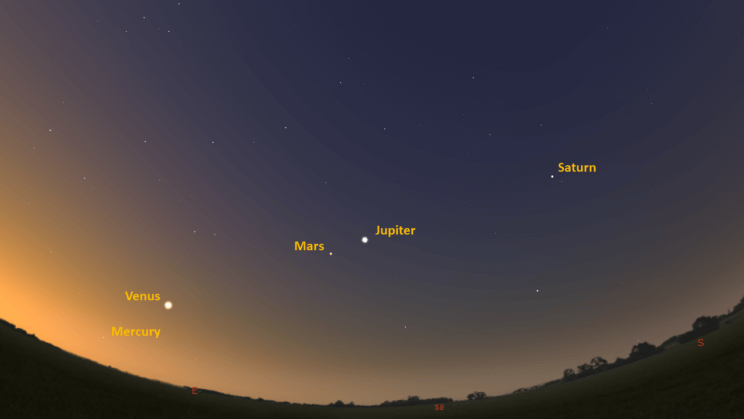This is the Saint Louis Science Center’s NIGHT SKY UPDATE for the week of Friday, June 10, 2022.
Information updated weekly or as needed.
Times given as local St. Louis time which is Central Daylight Time (CDT). For definitions of terminology used in the night sky update, click the highlighted text. If relying on times posted in Universal Time (UT), St. louis is -5 hours when CDT.
Public Telescope Viewings
Public telescope viewings at the McDonnell Planetarium have returned as part of the Saint Louis Science Center’s First Friday event. As we ease back into our telescope nights, they will operate a little different than before. To take part in our telescope viewings you will need to get a ticket for the planetarium show that starts at 7:00 p.m. as part of the First Friday event. Tickets for the First Friday planetarium show are free, but they can only be picked up at the Saint Louis Science Center on the night of the event. After the planetarium show ends you will be able to go outside and look through telescopes weather permitting. We will update this posting if anything changes.
Solar telescopes viewings have also returned and will take place every Sunday from 11:00 a.m. to 3:00 p.m. weather permitting. Solar Sundays will run from May 29, 2022, to September 4, 2022. The return of Solar Sundays is a good opportunity to prepare for the upcoming solar eclipses in 2023 and 2024.
Observing Highlight of the Week

Full moon seen on June 14, 2022. Image credit: NASA, SVS, Ernie Wright.
Full moon for June occurs on Tuesday June 14, 2022, at 11:52 a.m. For stargazers this is problematic as the Moon appears much brighter when near its full phase. Brighter stars and planets are good targets to observe when the Moon is near full, but those hunting deep sky objects will encounter issues.
The reason the Moon looks brighter during its full phase is the opposition effect. When the Moon is full, we see it near the anti-solar point or opposite the Sun in the sky. Because of this positioning, Shadows cast on the surface of the Moon by its topography are pointed away from us. This results in a higher ratio of bright to dark surface causing the Moon to appear brighter. This also decreases the contrast of the lunar surface making some details difficult to see. While the full moon is a pleasant sight to the unaided eye, it is generally frowned upon by observers.
Beyond observing issues, full moon offers us several other things to explore and learn about. Ancient humans long ago looked to the Moon to keep time. As they watched the Moon, they found it took 29.5 day to complete a cycle of phases. The lunar phase cycle is called a synodic month which was once how we kept time. Our modern calendar called the Gregorian calendar measures a cycle of seasons which is called a tropical year. During a tropical year there are roughly 12.4 synodic cycles of the Moon.
Aside from the synodic month, there are other types of months that represent different cycles of the Moon. A draconic month lasting 27.2 days, represents the period between passages of the Moon through the same orbital node. Orbital nodes are the points in which the Moon’s orbital plane crosses the Earth’s orbital plane. Draconic months are an important part of understanding and predicting eclipses. If new or full moons occur at one of the orbital nodes, an eclipse occurs. This happens because when at new and full moon, the Sun, Earth and Moon exhibit a syzygy. In astronomy, a syzygy is when three or more astronomical objects are aligned. Every synodic month a syzygy occurs at new and full moon. An eclipse only happens if a Sun-Earth-Moon alignment occurs at one of the orbital nodes. If a syzygy occurs when the Moon is at an orbital node, the syzygy is a more direct alignment allowing the shadow of the Moon or Earth to fall on the other depending on the alignment. Solar eclipses occur only at new moon and lunar eclipses only occur at full moon. The next eclipse we will see in St. Louis is a total lunar eclipse on November 8, 2022.
Another cycle of the Moon is the anomalistic month. Lasting 27.5 days, an anomalistic month is the period between successive perigees of the Moon. As the Moon orbits Earth, there is a near and far point in its orbit called apsides. Specifically for the Moon they are known as perigee (near) and apogee (far). The difference is small but at perigee the Earth-Moon distance is roughly 224,000 miles and at apogee 251,655 miles. When at perigee, the Moon will look about 14% larger and 30% brighter then when at apogee. This lunar cycle has an impact on the type of solar eclipse we see. Total solar eclipses occur when the Moon is near perigee while an annular solar eclipse occurs near apogee.
Another topic the anomalistic month impacts is the occurrence of high and low tides. Earth’s tides are caused by the Moon. The gravitational pull of the Moon generates tidal force that causes the water on Earth to bulge at the sublunar and antipodal points. If you are in one of these bulges you experience high tide and if you are 90° from the bulge you experience low tide. High and low tides become more extreme when the Moon reaches its new and full phase. This is because the Sun also impacts Earth’s tides. Much like the Moon, the Sun’s gravitational pull caused tidal forces on Earth. The tidal forces caused by the Sun are roughly 46% of the Moon’s tide-generating force. This is because it is much farther away.
When new and full moons occur the Sun, Earth and Moon are in a syzygy. At this point tidal forces are increased because both the Moon’s and Sun’s tidal forces join creating higher high tides and lower low tides. These are called spring tides which are strongest if the Moon is near perigee. Perigean spring tides occur three to four times a year. In June, perigee occurs about 12 hours after full Moon. Those traveling to costal locations this week should be aware of exceptionally high and low tides on June 14. 2022.
Studying the cycle of high and low tides also reveals changes induced by climate change. Due to sea levels rising, costal flooding during high tide has increased which can close roadways, damage costal environments and damage infrastructure. This flooding is minor when compared to major coastal flooding caused from costal storms, but it is a means to monitor the effects of sea-level rise.
The Moon is of interest for many reasons. For most, it is a wonderful target to observe and track over a month. Eclipses, occultations and conjunctions are other events that draw our attention to the Moon. Over the years we have learned about its impact on our culture, civilization and the lives of other creatures big and small. There is always a good reason to peak at the Moon.
To learn more about tides visit: https://scijinks.gov/tides/
To learn more about Eclipses visit: https://solarsystem.nasa.gov/moons
To learn how dung beetles navigate by moonlight visit: https://www.lunduniversity.lu.se/article/dung-beetles-navigate-better-under-full-moon
The Sun and Moon

The Moon as seen from the International Space Station, on July 31, 2011.
Credit: NASA
Sunrise is at 5:36 a.m. on Friday, June 10 and sunset is at 8:25 p.m. providing us with roughly 15 hours of daylight. Even after sunset, the light from the Sun will dimly illuminate our sky for roughly 1 hour and 50 minutes. This period is called twilight, which ends around 10:22 p.m. this week. For those with a sundial, local noon occurs around 1:00 p.m. this week.
| Day | Sunrise | Sunset |
|---|---|---|
| 2022-06-10 | 5:36 a.m. | 8:25 p.m. |
| 2022-06-11 | 5:36 a.m. | 8:25 p.m. |
| 2022-06-12 | 5:36 a.m. | 8:26 p.m. |
| 2022-06-13 | 5:36 a.m. | 8:26 p.m. |
| 2022-06-14 | 5:36 a.m. | 8:27 p.m. |
| 2022-06-15 | 5:36 a.m. | 8:27 p.m. |
| 2022-06-16 | 5:36 a.m. | 8:27 p.m. |
| 2022-06-17 | 5:36 a.m. | 8:28 p.m. |
| 2022-06-18 | 5:36 a.m. | 8:28 p.m. |
Moon
Moonrise for Friday, June 10 occurred at 4:12 p.m. and moonset will occur at 3:21 a.m. on the following morning. On Friday, June 10, the Moon will exhibit a waxing gibbous phase with 83% of the lunar disk illuminated. Full moon occurs on June 14, 2022, at 11:52 a.m.
International Space Station (ISS) Observing

There are no visible passes of ISS from St. Louis this week. There are a few great passes of the X-37B spacecraft. These occur in the morning of June 14 and 16. Use the table below for information about these passes. ISS will return to St. Louis skies on June 22, 2022.
Catch X-37B from St. Louis starting Friday, June 10
| Date | Starts | Max. altitude | Ends | |||||||
|---|---|---|---|---|---|---|---|---|---|---|
| Time | Alt. | Az. | Time | Alt. | Az. | Time | Alt. | Az. | ||
| 14 Jun | 0.3 | 04:35:29 | 16 | WSW | 04:37:37 | 79 | NNW | 04:40:30 | 10 | ENE |
| 16 Jun | 0.2 | 03:42:49 | 72 | W | 03:43:02 | 80 | NNW | 03:45:55 | 10 | ENE |
Magnitude (Mag): The Measure of brightness for a celestial object. The lower the value is, the brighter the object will be.
Altitude (Alt): The angle of a celestial object measured upwards from the observer’s horizon.
Azimuth (Az): The direction of a celestial object, measured clockwise from an observer’s location with north being 0°, east being 90°, south being 180° and west being 270°.
For information about ISS flyovers and other visible satellites, visit www.heavens-above.com
Detailed information regarding all unmanned exploration of our universe, missions past, present, and planned, can be found at Jet Propulsion Laboratories:
The Visible Planets

Looking southeast at 5:00 a.m. June 11, 2022. Credit: Stellarium, EG
This week, four naked eye planets are visible. Venus, Mars, Jupiter and Saturn are seen in the east and southeast before sunrise. Mercury will soon be visible in the east before sunrise.
Mercury
Mercury has started its next morning apparition. It will still be too low for most of us to spot the elusive planet, but it will soon join the other naked eye planets in the morning sky.
Venus
Venus has started a morning apparition and will be seen in the southeast before sunrise. Venus rises at 3:50 a.m. and should be easy to spot in the southeast by 5:00 a.m. The current morning apparition lasts until the third week of October 2022. Venus reaches superior conjunction on October 22, 2022.
Mars
A new apparition for Mars has begun. Mars rises at 2:21 a.m. Start looking for Mars around 3:30a.m. as it clears trees and buildings. Mars will continue to climb out of the Sun’s glare as it heads towards opposition later this year on December 7, 2022.
Jupiter
Jupiter rises at 2:00 a.m. and should be visible by 3:00 a.m. As the year goes on, Jupiter will rise about 20 minutes earlier than it did the week before. Jupiter will reach opposition on September 26, 2022, so our best views of this giant world will come at the end of summer and through the fall months.
Saturn
Saturn rises at 12:20 a.m. Start looking for Saturn around 1:30 a.m. in the southeastern sky. Saturn will reach opposition on August 14, 2022. As we head to this date, Saturn will rise earlier each day.
James S. McDonnell Planetarium
Night Sky Update: June 10 – June 18, 2022






